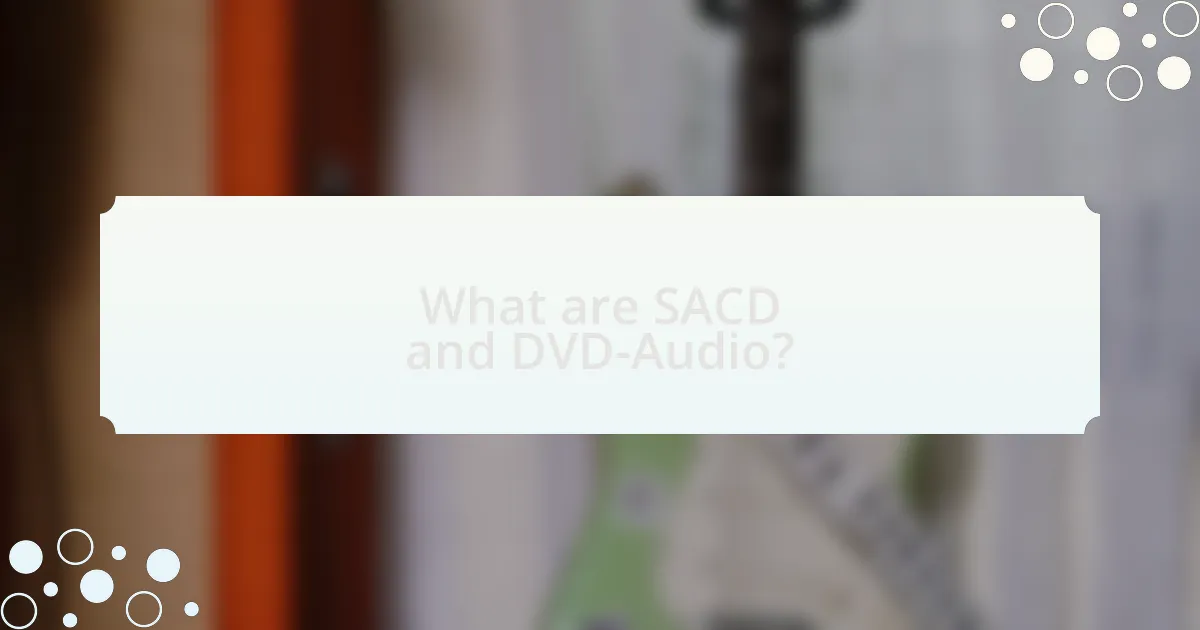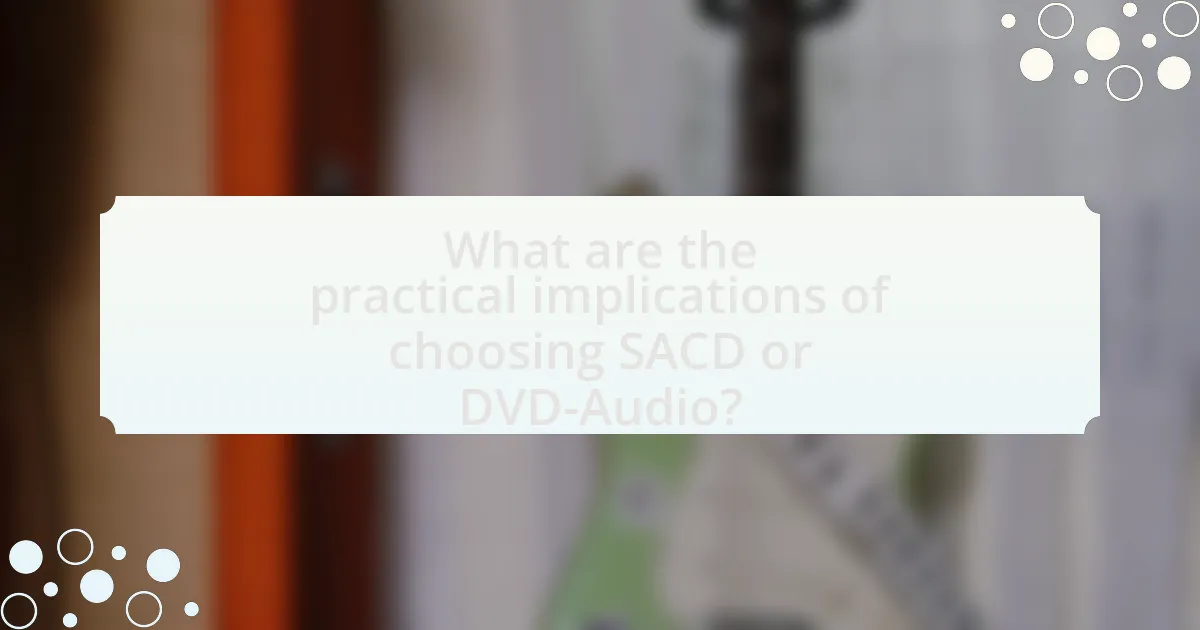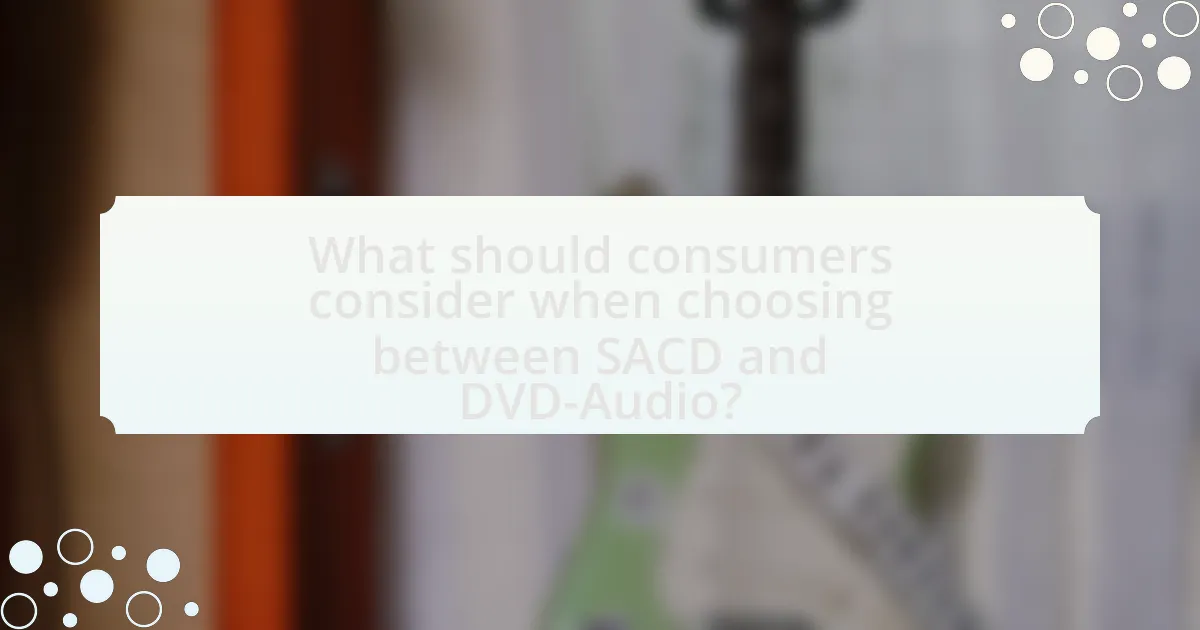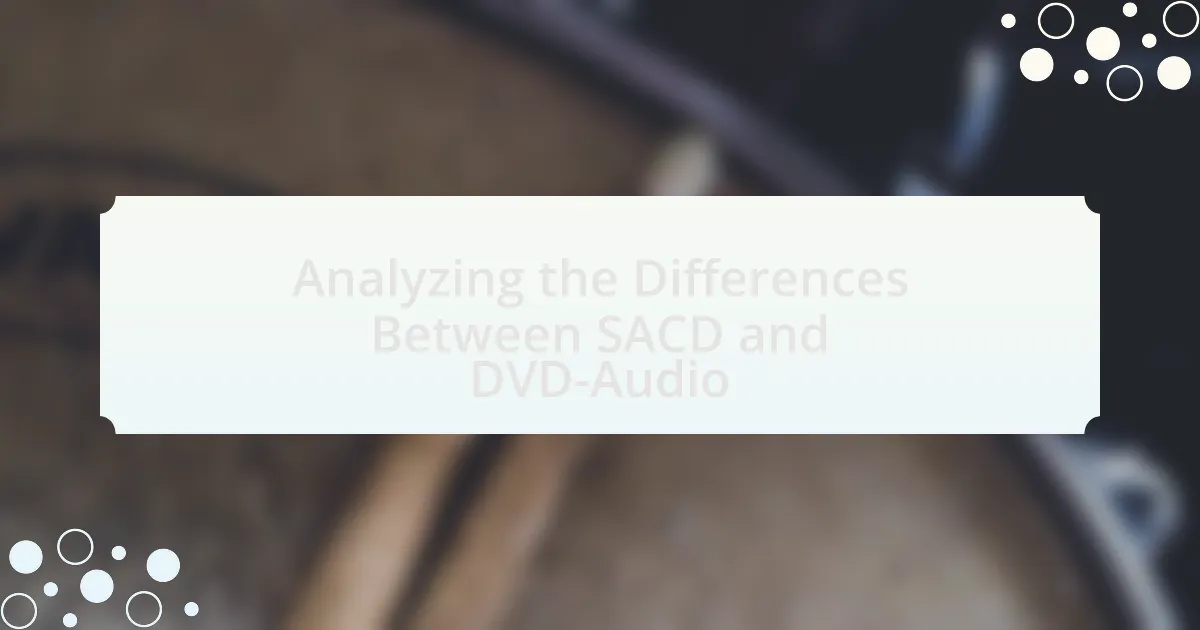SACD (Super Audio CD) and DVD-Audio are high-resolution audio formats that offer superior sound quality compared to standard CDs, each utilizing distinct technologies for audio encoding. SACD employs Direct Stream Digital (DSD) with a sampling rate of 2.8224 MHz, while DVD-Audio uses Pulse Code Modulation (PCM) with sample rates up to 192 kHz and bit depths of 24 bits. The article analyzes the technical differences, audio quality, compatibility, and content availability of both formats, highlighting their respective advantages and limitations. Additionally, it discusses practical considerations for consumers when choosing between SACD and DVD-Audio, including equipment compatibility and the impact of music genres on format preference.
What are SACD and DVD-Audio?

SACD (Super Audio CD) and DVD-Audio are both high-resolution audio formats designed to provide superior sound quality compared to standard CDs. SACD, introduced by Sony and Philips in 1999, utilizes a technology called Direct Stream Digital (DSD) to deliver audio with a sampling rate of 2.8224 MHz, which is significantly higher than the 44.1 kHz of standard CDs. DVD-Audio, launched in 2000, employs a different approach, using PCM (Pulse Code Modulation) audio with sample rates up to 192 kHz and bit depths of 24 bits, allowing for high-fidelity sound reproduction. Both formats aim to enhance the listening experience, but they differ in their technical specifications and playback compatibility, with SACD often requiring specialized players while DVD-Audio can be played on standard DVD players.
How do SACD and DVD-Audio differ in terms of technology?
SACD (Super Audio CD) and DVD-Audio differ primarily in their audio encoding technologies and storage capacities. SACD utilizes Direct Stream Digital (DSD) encoding, which captures audio in a one-bit format at a high sampling rate of 2.8224 MHz, allowing for a more natural sound reproduction. In contrast, DVD-Audio employs PCM (Pulse Code Modulation) encoding, which can support higher bit depths and sampling rates, typically up to 24-bit/192 kHz, providing flexibility in audio quality but often resulting in larger file sizes. Additionally, SACD discs can hold up to 4.7 GB of data for stereo and multi-channel audio, while DVD-Audio can store up to 8.5 GB, allowing for longer playtime and more content. These technological differences influence the overall audio experience and compatibility with playback devices.
What audio formats are supported by SACD?
SACD supports two main audio formats: DSD (Direct Stream Digital) and PCM (Pulse Code Modulation). DSD is the primary format used for high-resolution audio on SACDs, allowing for a sampling rate of 2.8224 MHz, which is significantly higher than standard CD audio. PCM is also supported, enabling compatibility with various audio systems and providing flexibility in audio playback. The inclusion of both formats allows SACD to deliver superior sound quality and versatility compared to traditional audio formats.
What audio formats are supported by DVD-Audio?
DVD-Audio supports several audio formats, including Linear PCM (LPCM), MLP (Meridian Lossless Packing), and various compressed formats such as Dolby Digital and DTS. Linear PCM is the primary format used for high-resolution audio, allowing for sample rates up to 192 kHz and bit depths of 24 bits. MLP is specifically designed for DVD-Audio to provide lossless compression, ensuring high-quality sound without data loss. The inclusion of Dolby Digital and DTS allows for multi-channel audio, enhancing the listening experience. These formats collectively enable DVD-Audio to deliver superior sound quality compared to standard audio CDs.
What are the key features of SACD?
The key features of SACD (Super Audio CD) include high-resolution audio, multi-channel sound capabilities, and a hybrid disc format. SACD supports audio sampling rates up to 2.8224 MHz, significantly higher than standard CDs, allowing for greater audio detail and fidelity. Additionally, SACD can deliver multi-channel audio, providing an immersive listening experience through formats like 5.1 surround sound. The hybrid disc format allows SACDs to contain both a high-resolution layer for SACD players and a standard CD layer for compatibility with regular CD players, enhancing accessibility for users.
How does SACD enhance audio quality?
SACD enhances audio quality by utilizing a higher sampling rate and bit depth compared to standard CDs, which allows for greater detail and dynamic range in sound reproduction. Specifically, SACD employs Direct Stream Digital (DSD) technology, sampling audio at 2.8224 MHz, significantly higher than the 44.1 kHz of CDs. This increased sampling rate captures more audio information, resulting in a more accurate and immersive listening experience. Additionally, SACD supports multi-channel audio, providing a surround sound experience that further enhances the overall audio quality.
What are the limitations of SACD?
SACD has several limitations, including limited compatibility with standard CD players, which restricts its playback to specialized devices. Additionally, the format’s high-resolution audio capabilities are often not fully utilized due to the lack of widespread support among music labels and the limited availability of SACD titles. Furthermore, SACD’s multi-channel audio features can complicate setup and playback for users without appropriate surround sound systems. Lastly, the production costs associated with SACD can lead to higher prices for consumers compared to other formats, limiting its market appeal.
What are the key features of DVD-Audio?
DVD-Audio features high-resolution audio, supporting up to 192 kHz/24-bit sound quality, which significantly surpasses CD audio quality. It utilizes advanced audio compression formats like MLP (Meridian Lossless Packing) to maintain audio fidelity while allowing for more content storage. DVD-Audio also supports multi-channel audio, enabling surround sound formats, which enhances the listening experience. Additionally, it offers interactive features such as on-screen graphics and menus, allowing users to navigate through tracks and additional content easily. These features collectively provide a superior audio experience compared to traditional formats.
How does DVD-Audio enhance audio quality?
DVD-Audio enhances audio quality by utilizing higher sampling rates and bit depths compared to traditional audio formats. Specifically, DVD-Audio supports up to 192 kHz sampling rates and 24-bit depth, allowing for a more detailed and dynamic sound reproduction. This technical capability results in a broader frequency range and improved signal-to-noise ratio, which contributes to a clearer and more accurate audio experience. Additionally, DVD-Audio can incorporate advanced audio formats such as multi-channel surround sound, further enriching the listening experience by providing immersive audio environments.
What are the limitations of DVD-Audio?
DVD-Audio has several limitations, primarily related to compatibility, content availability, and technical constraints. Firstly, DVD-Audio discs are not universally compatible with standard DVD players, as they require specific hardware to fully utilize their high-resolution audio capabilities. This limits the audience that can access DVD-Audio content. Secondly, the selection of music available in DVD-Audio format is significantly smaller compared to traditional CD formats and other digital formats, which restricts consumer choice. Additionally, DVD-Audio’s maximum audio resolution is 24-bit/192 kHz, which, while high, is still lower than some competing formats like SACD that offer DSD (Direct Stream Digital) encoding, potentially impacting audio fidelity for discerning listeners. These factors collectively hinder the widespread adoption and usability of DVD-Audio in the market.
What are the practical implications of choosing SACD or DVD-Audio?

Choosing between SACD (Super Audio CD) and DVD-Audio has practical implications primarily related to audio quality, compatibility, and content availability. SACD offers higher audio fidelity due to its DSD (Direct Stream Digital) format, which can provide a more immersive listening experience compared to the PCM (Pulse Code Modulation) used in DVD-Audio. However, SACD players are generally less common, limiting playback options. In contrast, DVD-Audio supports higher resolution audio and is more widely compatible with standard DVD players, making it more accessible for consumers. Additionally, the catalog of available titles differs, with SACD often featuring more classical and jazz recordings, while DVD-Audio includes a broader range of popular music. Thus, the choice between SACD and DVD-Audio affects not only sound quality but also the practicality of playback and available music selections.
How do SACD and DVD-Audio impact the listening experience?
SACD and DVD-Audio significantly enhance the listening experience by providing higher audio quality and multi-channel sound options. SACD utilizes Direct Stream Digital (DSD) technology, which offers a sampling rate of 2.8224 MHz, resulting in a more detailed and nuanced sound compared to standard CDs. DVD-Audio, on the other hand, supports higher resolution audio formats, including 24-bit/192 kHz PCM, allowing for greater dynamic range and clarity. Both formats enable multi-channel audio, creating an immersive listening environment that traditional stereo formats cannot achieve. The combination of superior audio fidelity and multi-channel capabilities in SACD and DVD-Audio leads to a richer and more engaging listening experience.
What are the differences in sound quality between SACD and DVD-Audio?
SACD (Super Audio CD) generally offers superior sound quality compared to DVD-Audio due to its higher sampling rates and bit depth. SACD utilizes Direct Stream Digital (DSD) encoding, which operates at a 2.8224 MHz sampling rate and 1-bit depth, allowing for a more accurate representation of audio signals. In contrast, DVD-Audio typically employs PCM (Pulse Code Modulation) with a maximum sampling rate of 192 kHz and a bit depth of 24 bits. This difference in encoding methods results in SACD providing a more natural and detailed sound reproduction, particularly in the high-frequency range. Additionally, SACD supports multi-channel audio formats, enhancing the immersive listening experience, while DVD-Audio also supports multi-channel but may not achieve the same level of fidelity.
How do user interfaces differ between SACD and DVD-Audio players?
User interfaces for SACD players typically emphasize a more straightforward navigation experience, often featuring fewer menu options and a focus on audio playback quality. In contrast, DVD-Audio players generally provide more complex interfaces that include extensive multimedia features, such as video playback and interactive menus. This complexity in DVD-Audio interfaces is due to their design to accommodate both high-resolution audio and additional content, which necessitates a more elaborate user interaction model.
What are the cost considerations for SACD and DVD-Audio?
The cost considerations for SACD and DVD-Audio primarily involve production, licensing, and consumer pricing. SACD production typically incurs higher costs due to the need for specialized equipment and licensing fees associated with the Super Audio CD format, which can lead to higher retail prices for consumers. In contrast, DVD-Audio benefits from existing DVD production infrastructure, resulting in lower manufacturing costs and potentially more competitive pricing in the market. Additionally, the market demand and availability of titles can influence the overall cost, with SACD often being perceived as a premium product, thus commanding higher prices compared to DVD-Audio.
How do the prices of SACD and DVD-Audio discs compare?
SACD discs generally have higher prices compared to DVD-Audio discs. The average price for SACD titles typically ranges from $20 to $40, while DVD-Audio discs are often priced between $10 and $25. This price difference can be attributed to the more limited production and niche market of SACDs, as well as the higher manufacturing costs associated with their advanced audio technology.
What are the costs associated with SACD and DVD-Audio players?
The costs associated with SACD and DVD-Audio players typically range from $200 to $1,500, depending on the brand, features, and audio quality. For instance, entry-level models may start around $200, while high-end players can exceed $1,000, reflecting advanced technology and superior sound performance. Additionally, the market for these players has seen fluctuations, with some models becoming rare collectibles, further impacting their prices.
What should consumers consider when choosing between SACD and DVD-Audio?

Consumers should consider audio quality, compatibility, and available content when choosing between SACD and DVD-Audio. SACD typically offers superior audio quality due to its DSD (Direct Stream Digital) format, which provides a higher sampling rate and better dynamic range compared to the PCM (Pulse Code Modulation) used in DVD-Audio. Compatibility is another crucial factor; SACD players can often play standard CDs, while DVD-Audio requires a compatible DVD player, limiting its accessibility. Additionally, the selection of titles varies, with SACD having a more extensive catalog of classical and jazz recordings, while DVD-Audio may offer more rock and pop albums. These considerations help consumers make an informed choice based on their preferences and equipment.
What factors influence the choice between SACD and DVD-Audio?
The choice between SACD and DVD-Audio is influenced by factors such as audio quality, compatibility, and content availability. SACD offers higher audio fidelity due to its DSD (Direct Stream Digital) format, which is often preferred by audiophiles for its superior sound reproduction. In contrast, DVD-Audio supports higher resolution PCM (Pulse Code Modulation) audio, which can also deliver excellent sound quality but may not match the DSD experience. Compatibility is another critical factor; SACD players are generally less common than DVD players, which can limit access to SACD content. Additionally, the availability of titles varies, with some music genres being more prevalent in one format over the other, affecting consumer choice.
How does the type of music affect the choice between SACD and DVD-Audio?
The type of music significantly influences the choice between SACD and DVD-Audio due to their differing audio capabilities and target audiences. SACD, which supports high-resolution audio formats, is often preferred for classical and jazz genres where audio fidelity and dynamic range are paramount. In contrast, DVD-Audio, while also capable of high-resolution sound, is more commonly associated with rock and pop music, where the emphasis may be on surround sound and additional multimedia features. This distinction is supported by the fact that SACD’s DSD (Direct Stream Digital) format provides a more natural sound reproduction, making it ideal for intricate musical compositions, while DVD-Audio’s PCM (Pulse Code Modulation) format allows for greater flexibility in mixing and mastering, appealing to contemporary music producers.
What role does equipment compatibility play in the decision?
Equipment compatibility is crucial in the decision between SACD and DVD-Audio, as it determines whether the playback devices can support the chosen format. For instance, SACD requires specific players that can decode its DSD (Direct Stream Digital) format, while DVD-Audio can be played on standard DVD players that support the format. This compatibility directly influences consumer choices, as users are more likely to select a format that is supported by their existing equipment, ensuring a seamless listening experience.
What are the best practices for enjoying SACD and DVD-Audio?
To enjoy SACD and DVD-Audio, use high-quality playback equipment that supports these formats, such as dedicated SACD players or universal players that can handle both SACD and DVD-Audio. This ensures optimal sound quality, as these formats are designed for high-resolution audio. Additionally, select well-mastered discs, as the quality of the recording significantly impacts the listening experience. For the best results, connect your player to a high-fidelity audio system, utilizing quality cables to minimize signal loss. Finally, ensure your listening environment is acoustically treated to enhance sound clarity and immersion.
How can listeners optimize their setup for SACD playback?
Listeners can optimize their setup for SACD playback by ensuring they use a dedicated SACD player or a compatible universal player that supports SACD formats. This is crucial because SACD utilizes a different encoding method (DSD) compared to standard CDs and other formats, which requires specific hardware to decode properly. Additionally, connecting the player to a high-quality audio system with a capable DAC (Digital-to-Analog Converter) enhances sound quality, as SACD is designed to deliver high-resolution audio. Using high-quality cables, such as HDMI or analog interconnects, can further improve signal integrity and reduce interference, ensuring that the full audio potential of SACD is realized.
What tips can enhance the DVD-Audio listening experience?
To enhance the DVD-Audio listening experience, use high-quality audio equipment, including a dedicated DVD-Audio player and surround sound system. High-quality equipment ensures accurate sound reproduction, which is crucial for the multi-channel audio formats that DVD-Audio supports. Additionally, selecting well-mastered discs can significantly improve audio fidelity, as mastering quality directly affects the listening experience. Proper speaker placement and room acoustics also play a vital role; positioning speakers correctly and treating the room acoustically can minimize sound distortion and enhance clarity. Finally, utilizing lossless audio formats available on DVD-Audio can provide a richer listening experience, as these formats preserve the original sound quality better than compressed formats.

Leave a Reply